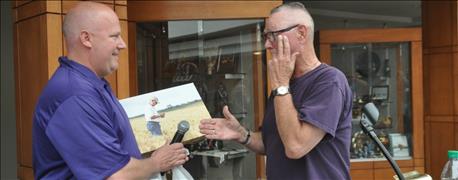
After 25 years, Wheat Quality Council executive vice president Ben Handcock is hanging up his yardstick.
"Well this is one hell of a wheat crop to remember as my last dance," Handcock said as the Hard Red Winter Wheat Quality Tour wrapped up on May 5. "I don't know if it's the best Kansas wheat crop I've seen in 25 years of doing this, but it is sure one of the best."
Handcock will still be at the helm of the WQC for this summer's hard spring and durum wheat tour in North Dakota, South Dakota and Minnesota and he will preside of the annual meeting next February.

EMOTIONAL MOMENT: Wheat Quality Council executive vice president Ben Handcock, right, wipes a tear as he accepts a wall hanging photo of him in a Kansas wheat field from Kansas Wheat CEO Justin Gilpin.
"We are taking applications for my position now and hope to have someone on board by November to get that person acclimated before I leave," Handcock said.
His plans include retirement to his Fort Luptin, Colo. home, playing golf and watching his youngest grandson, Braden, play his last year of high school basketball.
Handcock and his wife, Patsy, have three children, nine grandchildren and nine great-grandchildren with a tenth on the way.
"We started young," he says. "Patsy was a grandmother at 39. I was 40. I'm looking forward to retirement and to time with all of them."
Handcock is a 1968 graduate of Colorado State University and was in the first class to be able to major in Agriculture Industries Management.
After college he spent a few years in farming and ranching near Pierre, S.D. before selling the farm and going to work for the South Dakota Wheat Commission.
After a 10-year stint there, he took over as Executive Vice President for the Wheat Quality Council.
He's a well-known figure on the tour circuit, unmercifully ribbing participants who are late to show up for departure time in the morning, but always good-humored and joking.
"He's been the heart and soul of this tour and he's absolutely going to be missed," said tour veteran Dave Green with ADM Milling.
Handcock maintained a jovial "last rodeo" stance right up to the point where Kansas Wheat CEO JustinGilpin presented him with a wall hanging photo of Handcock in a Kansas wheat field, shot during last year's tour.
"We want to give you this hanging for your wall to let you know that in our hearts, you are forever in a wheat field with us," he said.
Handcock walked to the podium fighting tears.
"I knew this would happen," he said. "Damn it, I cry at everything. I just cry."
The audience, a majority of which had met Handcock only three days earlier, was emotional as well, realizing that they were witnessing the passing of an era in Kansas wheat history.
While the annual tours get the most publicity of the WQC's work, the primary job of the council is testing every variety of wheat developed by U.S. wheat breeders for milling and baking qualities before release.
"We get three bushels of wheat of each new variety and send it out to the millers to mill into flour. And then we send the flour to various baking companies have them test the baking qualities," Handcock says. "We put all the results online for the industry to assess."
Handcock said breeders are free to release varieties even if they don't perform well in the quality tests, but most don't.
"There are a ton of varieties that never get released for one reason or another," he said. "Most farmers want the better yields but if you have a variety that doesn't provide acceptable milling and baking qualities, there is a problem."
He said the WQC annually tests about 30 winter wheat varieties and about 20 spring wheats.
About the Author(s)
You May Also Like






